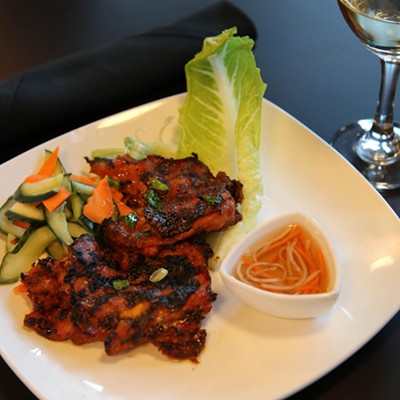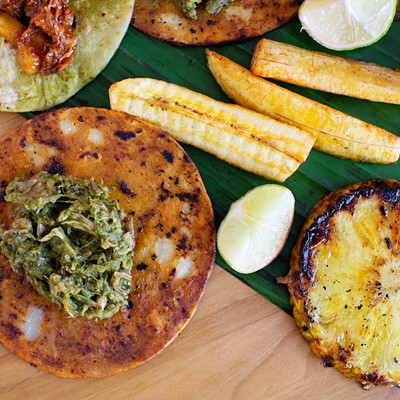Somalia is located on the Horn of Africa, a bit of land that juts out into the Gulf of Aden and the Indian Ocean. This prime location was a vital part in the spice-trade routes between Europe and India in the late-15th and early-16th centuries.
Both Italy and Britain once held the country as a territory. As such, Somali cuisine is a blend of culinary influences—but halal, the Islamic code of permissible food, is strictly followed.
Not all of the food at Nur Market's restaurant is Somali (even though the owners are), but the dishes served there give diners a window into a cuisine that could be on the verge of getting lost, due to current instability.
The market itself is a worldly wonder. Nur isn't a fancy place; it's more like an old-fashioned corner store, with imported goods from around the globe. The shelves are filled with semolina flour, sesame candy, roasted and raw nuts of all sorts, dried and canned chickpeas, Moroccan sardines, brightly colored bulk spices, big bags of basmati rice, canned baba ghanoush ... I could go on and on, but suffice it to say, the choices are amazing.
Calling the dining area decor "minimalist" would be kind. The small room tucked in the back of the market holds a dozen tables, chairs, an order counter and a big-screen TV. The menu, including about a dozen items in all (with some items available in both entrée and sandwich forms), is taped to the counter.
What's lacking in décor is more than made up for in presentation and portion size. The plates are a riot of golds and reds, greens and browns, oranges and yellows. The plates are overflowing with food, all halal.
The service was upbeat. The same young man was our server on both visits. He had a smile that could light up a room and was most helpful in explaining items despite a language barrier.
We began with sambusas (99 cents). These are comparable to Indian samosas—but I've never had samosas so crispy and flavorful. The little pies were hot out of the fryer, and the golden-brown dumplings crackled as we bit into them. Inside was plenty of moist, lightly seasoned, finely ground beef, along with tiny toothsome potato cubes, a little bit of onion and garlic, and some flecks of green. There's a flash of spicy heat, but that fades away as you dig in further. These triangular treats are snacks in Somalia, and it's easy to see why they are so popular. There are many layers of flavor and texture, all packed into an easy-to-carry, edible package.
Entrée portions are enormous. They all come with rice pilaf, a green salad and maraq.
Maraq seems to be one of those dishes with as many versions as there are cooks. (During our two visits, we got two slightly different preparations.) At Nur, this Somali vegetable stew is rich with pureed tomatoes, onions, potatoes, corn, green beans, okra pods and whatever other vegetables that might be on hand. You're left with a warm feeling in the back of your throat.
The pilaf—in Somalia, it's called bariis—was nothing short of wonderful: aromatic, brightly colored, fluffy and light. It could easily be a stand-alone meal. (In Somalia, it is often the main dish, with meats and veggies as side dishes.) You wonder how anything so simple could be so delectable.
The salad was basically head lettuce, tomato slices and the tiniest, sweetest cucumbers I've ever tasted. A swirl of a creamy dressing, probably yogurt-based, sits on top.
Grilled entrées include beef shish kabob ($8.99) and chicken shawarma ($8.99). The kabob consisted of two 10-inch skewers jammed with tender beef cubes, sweet grilled onions and tomatoes that were on the verge of melting.
The long, thin strips of the shawarma were golden from the spices and grilled to a toasty brown. The chicken was tender and fragrant with a wonderful assortment of savory spices.
Slow-cooked items include goat curry ($10.99) and lamb shank ($10.99). Both were tender and tasty; the lamb easily pulled away from the bone. Spices permeated the meat, adding a nice finish.
There were bones in the curry, but because the goat meat had slowly simmered for hours, it also pulled away easily from the bone. The curry flavors were subtle, but there. All too often, curry is over-sauced and over-seasoned; not so at Nur.
Samples of vegetable soup were being given away during one visit. It was not quite the color of lentil soup and was certainly not as thick; you could taste and see the roughly pureed potatoes, carrots and herbs. Lime slices were served alongside, and with a squeeze, the soup became brighter, and the flavors more pronounced.
We wanted to try the specialty coffee ($1), but it wasn't yet ready, so we opted for the tea ($1). Dark and aromatic from the green cardamom, cinnamon and ginger, the tea was both sweet and spicy.
The history of American immigration can be traced through restaurants. As people came to this country from Italy, Greece or China, they opened restaurants. It was something they could do easily with limited English skills, and it was a way to stay connected to friends, and to create jobs for family members who wanted to come over. Nur Market and Restaurant is a reflection of that phenomenon, as thousands of people are migrating today from Eastern Africa due to war and political instability.
Somalia's loss is Tucson's gain. What a most welcome addition to Tucson's culinary scene!








